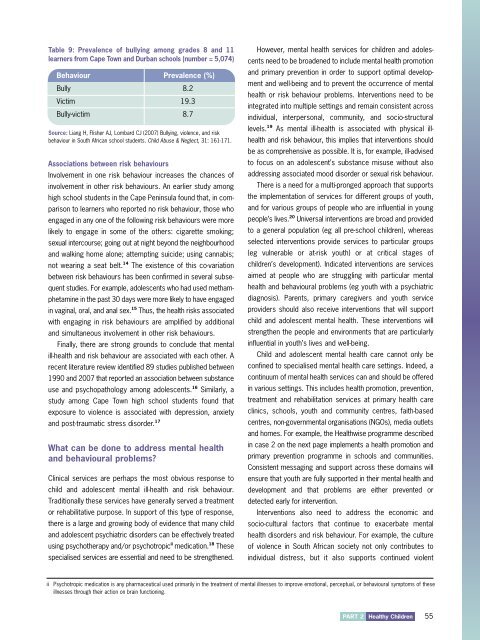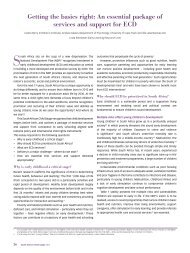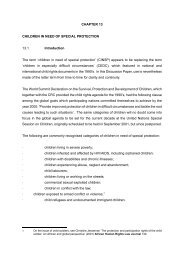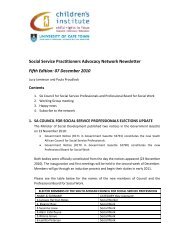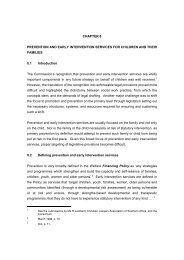Mental health and risk behaviour
Mental health and risk behaviour
Mental health and risk behaviour
Create successful ePaper yourself
Turn your PDF publications into a flip-book with our unique Google optimized e-Paper software.
Table 9: Prevalence of bullying among grades 8 <strong>and</strong> 11<br />
learners from Cape Town <strong>and</strong> Durban schools (number = 5,074)<br />
Behaviour Prevalence (%)<br />
Bully 8.2<br />
Victim 19.3<br />
Bully-victim 8.7<br />
Source: Liang H, Flisher AJ, Lombard CJ (2007) Bullying, violence, <strong>and</strong> <strong>risk</strong><br />
<strong>behaviour</strong> in South African school students. Child Abuse & Neglect, 31: 161-171.<br />
Associations between <strong>risk</strong> <strong>behaviour</strong>s<br />
Involvement in one <strong>risk</strong> <strong>behaviour</strong> increases the chances of<br />
involvement in other <strong>risk</strong> <strong>behaviour</strong>s. An earlier study among<br />
high school students in the Cape Peninsula found that, in comparison<br />
to learners who reported no <strong>risk</strong> <strong>behaviour</strong>, those who<br />
engaged in any one of the following <strong>risk</strong> <strong>behaviour</strong>s were more<br />
likely to engage in some of the others: cigarette smoking;<br />
sexual intercourse; going out at night beyond the neighbourhood<br />
<strong>and</strong> walking home alone; attempting suicide; using cannabis;<br />
not wearing a seat belt. 14 The existence of this co-variation<br />
between <strong>risk</strong> <strong>behaviour</strong>s has been confirmed in several subsequent<br />
studies. For example, adolescents who had used methamphetamine<br />
in the past 30 days were more likely to have engaged<br />
in vaginal, oral, <strong>and</strong> anal sex. 15 Thus, the <strong>health</strong> <strong>risk</strong>s associated<br />
with engaging in <strong>risk</strong> <strong>behaviour</strong>s are amplified by additional<br />
<strong>and</strong> simultaneous involvement in other <strong>risk</strong> <strong>behaviour</strong>s.<br />
FinalIy, there are strong grounds to conclude that mental<br />
ill-<strong>health</strong> <strong>and</strong> <strong>risk</strong> <strong>behaviour</strong> are associated with each other. A<br />
recent literature review identified 89 studies published between<br />
1990 <strong>and</strong> 2007 that reported an association between substance<br />
use <strong>and</strong> psychopathology among adolescents. 16 Similarly, a<br />
study among Cape Town high school students found that<br />
exposure to violence is associated with depression, anxiety<br />
<strong>and</strong> post-traumatic stress disorder. 17<br />
What can be done to address mental <strong>health</strong><br />
<strong>and</strong> <strong>behaviour</strong>al problems?<br />
Clinical services are perhaps the most obvious response to<br />
child <strong>and</strong> adolescent mental ill-<strong>health</strong> <strong>and</strong> <strong>risk</strong> <strong>behaviour</strong>.<br />
Traditionally these services have generally served a treatment<br />
or rehabilitative purpose. In support of this type of response,<br />
there is a large <strong>and</strong> growing body of evidence that many child<br />
<strong>and</strong> adolescent psychiatric disorders can be effectively treated<br />
using psychotherapy <strong>and</strong>/or psychotropic ii medication. 18 These<br />
specialised services are essential <strong>and</strong> need to be strengthened.<br />
However, mental <strong>health</strong> services for children <strong>and</strong> adolescents<br />
need to be broadened to include mental <strong>health</strong> promotion<br />
<strong>and</strong> primary prevention in order to support optimal development<br />
<strong>and</strong> well-being <strong>and</strong> to prevent the occurrence of mental<br />
<strong>health</strong> or <strong>risk</strong> <strong>behaviour</strong> problems. Interventions need to be<br />
integrated into multiple settings <strong>and</strong> remain consistent across<br />
individual, interpersonal, community, <strong>and</strong> socio-structural<br />
levels. 19 As mental ill-<strong>health</strong> is associated with physical ill<strong>health</strong><br />
<strong>and</strong> <strong>risk</strong> <strong>behaviour</strong>, this implies that interventions should<br />
be as comprehensive as possible. It is, for example, ill-advised<br />
to focus on an adolescent’s substance misuse without also<br />
addressing associated mood disorder or sexual <strong>risk</strong> <strong>behaviour</strong>.<br />
There is a need for a multi-pronged approach that supports<br />
the implementation of services for different groups of youth,<br />
<strong>and</strong> for various groups of people who are influential in young<br />
people’s lives. 20 Universal interventions are broad <strong>and</strong> provided<br />
to a general population (eg all pre-school children), whereas<br />
selected interventions provide services to particular groups<br />
(eg vulnerable or at-<strong>risk</strong> youth) or at critical stages of<br />
children’s development). Indicated interventions are services<br />
aimed at people who are struggling with particular mental<br />
<strong>health</strong> <strong>and</strong> <strong>behaviour</strong>al problems (eg youth with a psychiatric<br />
diagnosis). Parents, primary caregivers <strong>and</strong> youth service<br />
providers should also receive interventions that will support<br />
child <strong>and</strong> adolescent mental <strong>health</strong>. These interventions will<br />
strengthen the people <strong>and</strong> environments that are particularly<br />
influential in youth’s lives <strong>and</strong> well-being.<br />
Child <strong>and</strong> adolescent mental <strong>health</strong> care cannot only be<br />
confined to specialised mental <strong>health</strong> care settings. Indeed, a<br />
continuum of mental <strong>health</strong> services can <strong>and</strong> should be offered<br />
in various settings. This includes <strong>health</strong> promotion, prevention,<br />
treatment <strong>and</strong> rehabilitation services at primary <strong>health</strong> care<br />
clinics, schools, youth <strong>and</strong> community centres, faith-based<br />
centres, non-governmental organisations (NGOs), media outlets<br />
<strong>and</strong> homes. For example, the Healthwise programme described<br />
in case 2 on the next page implements a <strong>health</strong> promotion <strong>and</strong><br />
primary prevention programme in schools <strong>and</strong> communities.<br />
Consistent messaging <strong>and</strong> support across these domains will<br />
ensure that youth are fully supported in their mental <strong>health</strong> <strong>and</strong><br />
development <strong>and</strong> that problems are either prevented or<br />
detected early for intervention.<br />
Interventions also need to address the economic <strong>and</strong><br />
socio-cultural factors that continue to exacerbate mental<br />
<strong>health</strong> disorders <strong>and</strong> <strong>risk</strong> <strong>behaviour</strong>. For example, the culture<br />
of violence in South African society not only contributes to<br />
individual distress, but it also supports continued violent<br />
ii Psychotropic medication is any pharmaceutical used primarily in the treatment of mental illnesses to improve emotional, perceptual, or <strong>behaviour</strong>al symptoms of these<br />
illnesses through their action on brain functioning.<br />
PART 2 Healthy Children<br />
55


